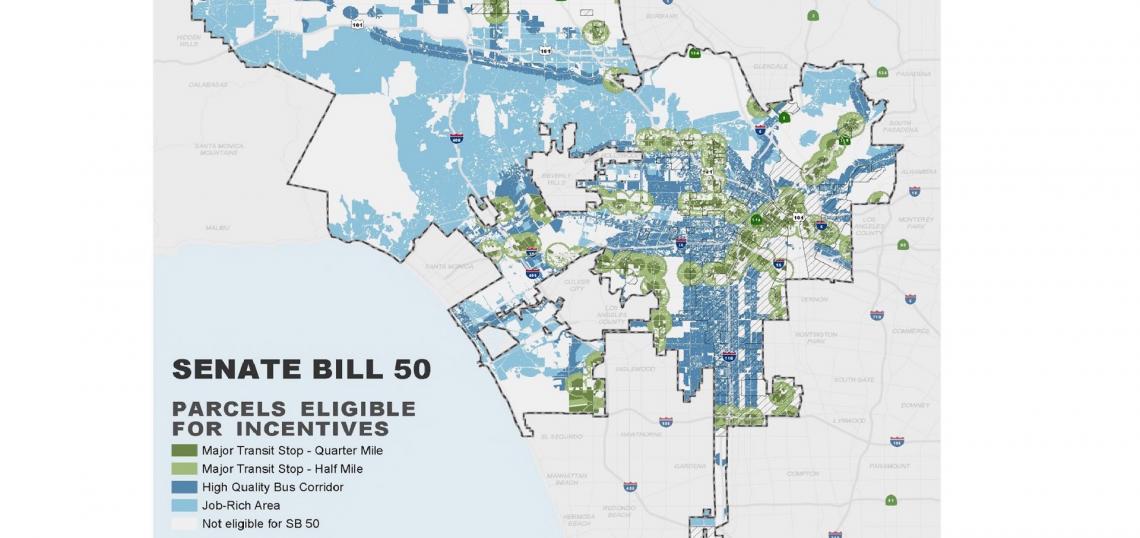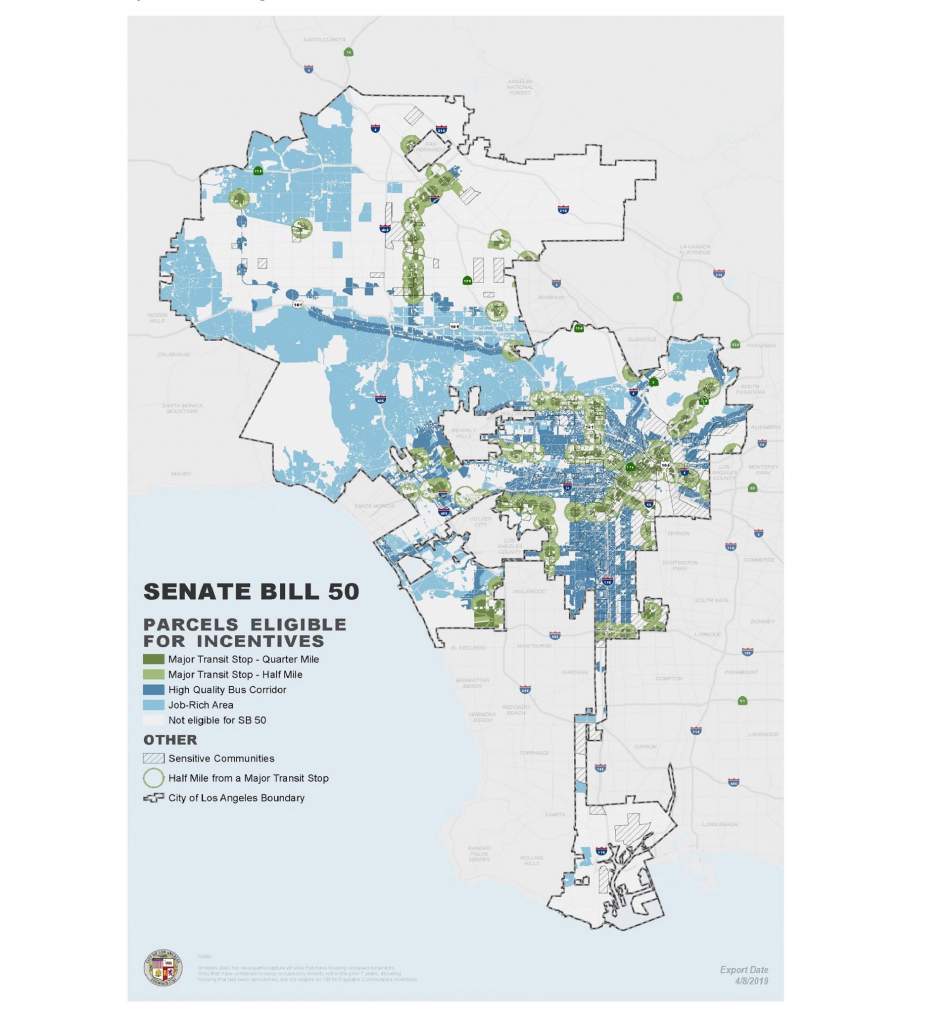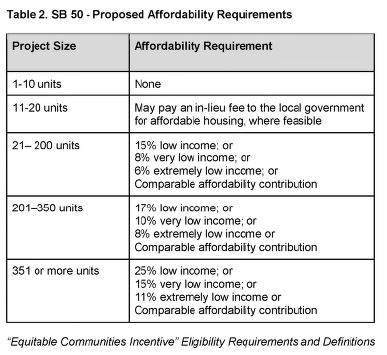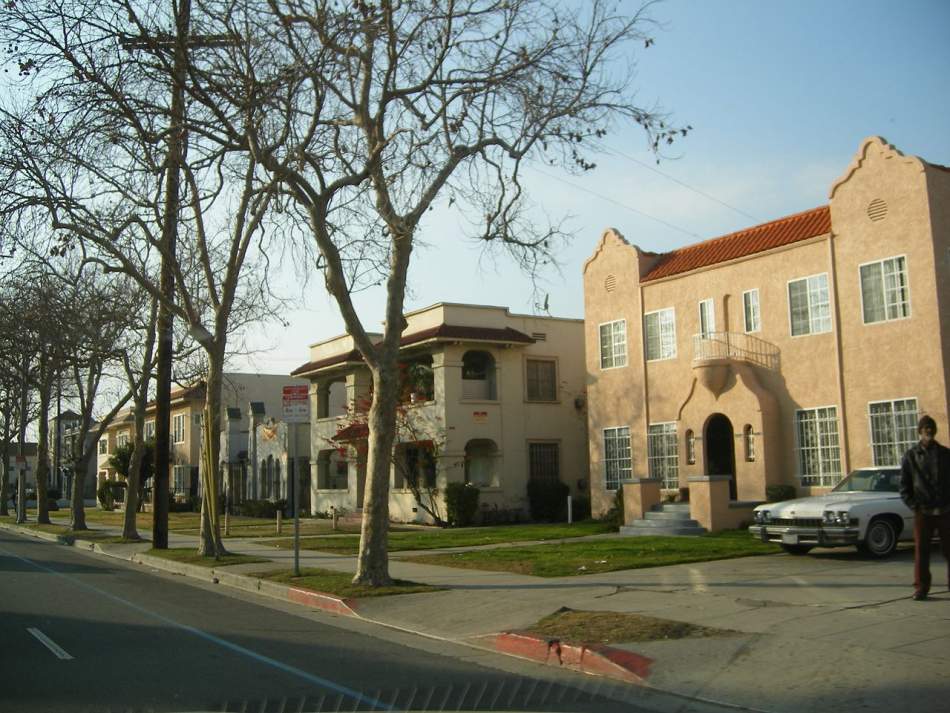A bill now being considered by the California State Legislature could impact the zoning of nearly half of the land in the City of Los Angeles, according to a report published yesterday by the Department of City Planning.
SB 50, introduced late in 2018 by San Francisco Senator Scott Wiener, would permit the construction of four- and five-story apartment buildings near transit corridors and job centers, even when local zoning regulations disallow such developments. The analysis by the Planning Department found that approximately 43 percent of the developable area in the City of Los Angeles could be eligible for the incentives proposed by the legislation.
The largest impacts are anticipated in lower-density areas located within a half-mile of rail stations - which accounts for approximately 6 percent of all single-family zoned land in the city and approximately 8 percent of land zoned for duplexes and smaller multifamily residential buildings - as these areas would be eligible for substantial increases in allowable height, floor area, and density. Accordingly, should SB 50 be adopted, development could move away from commercial corridors and existing high-density zoned areas into currently low-density zoned areas.
The mechanism by which SB 50 aims to foster new housing construction statewide - putting California on the path to creating 3.5 million homes by the year 2025 - is the "equitable communities incentive," - a new variant of the statewide density bonus. Projects eligible for equitable community incentives would be required to meet certain criteria, including on-site affordable housing targets, and location within a half-mile of a rail station or a quarter-mile of frequent bus service. Proposed affordability targets and incentives are as follows:
Major transit stops are defined as an existing or future rail transit stations and ferry terminals. High-quality bus corridors are defined as those with fixed-route bus service that have average service intervals of no more than 15 minutes during peak hours, no more than 20 minutes during off-peak hours, and no more than 30 minutes during weekends.
Less clear at at this point in time are the "job-rich areas," which are to be defined by the California Department of Housing and Community Development and updated every five years starting in January 1, 2020. Although no statewide map has been released to date, the Planning Department's analysis relies on data compiled through the Mapping Opportunity in California project, which considers "higher opportunity" census tracts to be those in which residents of all income levels are more likely to achieve positive educational and economic outcomes. Eligible census tracts are also located in proximity to jobs-rich areas, measured by employment density and job totals, thus enabling shorter commute distances for residents when compared to the status quo.
The affordability targets of SB 50 have been the subject of criticism by affordable housing and equity-focused groups, which argue that too low given the incentives offered by the legislation. The Planning Department also notes that the affordability levels required by SB 50 are in some cases lower than those required by the statewide density bonus and the City of Los Angeles' Transit Oriented Communities incentives. However, should a jurisdiction have an existing inclusionary housing law that imposes higher affordability requirements than those specified by SB 50, the local requirement would be considered the minimum standard? Likewise, local affordable housing production programs that offer more generous incentives than SB 50 - such as the TOC guidelines - would also remain in place.
SB 50 also incorporates several protections for existing rental housing and sensitive communities which could potentially reduce its impacts in large parts of Los Angeles. The legislation would not apply to any property which has had a rental tenant in the past seven years - even if the units are currently vacant or have been demolished. Properties removed from the rental market through the Ellis Act within the past 15 years would be similarly ineligible for SB 50's incentives.
Additionally, areas designated as "sensitive communities," by the California Department of Housing and Community Development would be exempted from SB 50 for a period of five years, providing time for local planning efforts to create a viable alternative to the measured imposed by the legislation. These communities are defined as those in which 30% or more of a census tract lives below the poverty line and the location quotient of residential racial segregation is at least 1.25. However, as the sensitive communities of Los Angeles have not been identified at this point in time, the Planning Department relied on data from the California Tax Credit Allocation Committee Opportunity Area Maps to conduct its analysis, finding that such communities would account for approximately 15% of parcels eligible for SB 50 incentives.
SB 50's definition of sensitive communities has also been the subject of criticism from housing and equity groups, who note that the current criteria would exclude neighborhoods such as Leimert Park that are experiencing gentrification. The Los Angeles Times reported yesterday that Wiener intends to introduce an amendment to this section of the bill, which would add a temporary exemption for "potentially sensitive" neighborhoods, as well as the consideration of factors such as income, unemployment, proximity to pollutants, and high rent burden.
The report points to several areas of lingering uncertainty as SB 50 moves forward.
Local land use regulations pertaining to historic preservation, hillside areas, flood zones, fire hazard areas, and coastal properties are not addressed at length in the bill, though the legislation would likely supersede some of the City's design and preservation controls. The Planning Department reports that the bill would curtail the City's ability to set regulations on building mass, density, parking, setbacks, and height in eligible areas, and may also roll back some regulations pertaining to historic preservation overlay zones.
The requirement that SB 50 projects be able to request up to three additional "incentives or concessions," adds another layer of uncertainty, though obtaining those incentives would require an increase in on-site affordable housing for each project. The lack of specifics in this provision of SB 50 could "greatly affect impacts to bulk and form, particularly in lower-scale neighborhoods." In comparison, the TOC and density bonus programs offer a menu of incentives that provides a greater degree of certainty.
Additionally, while the "sensitive communities" designation would delay implementation in neighborhoods at risk of displacement, the bill would nonetheless supersede recently adopted plans across Los Angeles - including the twin South Los Angeles Community Plans. The Planning Department notes that these plans increased housing capacity by approximately 20,000 units, with density targeted around transit hubs, and existing rent-stabilized neighborhoods left largely untouched. Future community plans in sensitive communities would only be recognized if their baseline zoning matches the levels required by SB 50.
Regardless of its political implications, the Planning Department describes SB 50 as a "bold and aggressive attempt to respond to California's housing crisis," in addition being an avenue for the City of Los Angeles to meet its sustainability goals and overcome legacies of redlining, segregation and exclusionary zoning. The report concludes by noting that while the City of Los Angeles permitted over 21,000 new housing units in 2018 - its highest total in nearly 30 decades - this spike in production is only slightly above the nationwide average, and well behind cities such as Seattle, Austin, Atlanta, and Irvine.
Update - Additional amendments unveiled by Wiener on April 24 include:
- In counties with 600,000 people or more, areas within a half-mile or rail and ferry stations will be eligible for SB 50 incentives.
- Areas within a quarter-mile of bus stops will also be eligible for incentives, but the definition of high-frequency bus service has been changed to every 10 minutes intead of every 15 minutes.
- Fourplexes would be allowed by-right statewide; buildings could not be demolished for new fourplexes, but existing homes can be internally subdivided.
- In counties with less than 600,000 residents, a half-mile radius surrounding rail and ferry stations would be eligible for SB 50 incentives in cities with over 50,000 residents.
- SB 50 (Urbanize LA)











